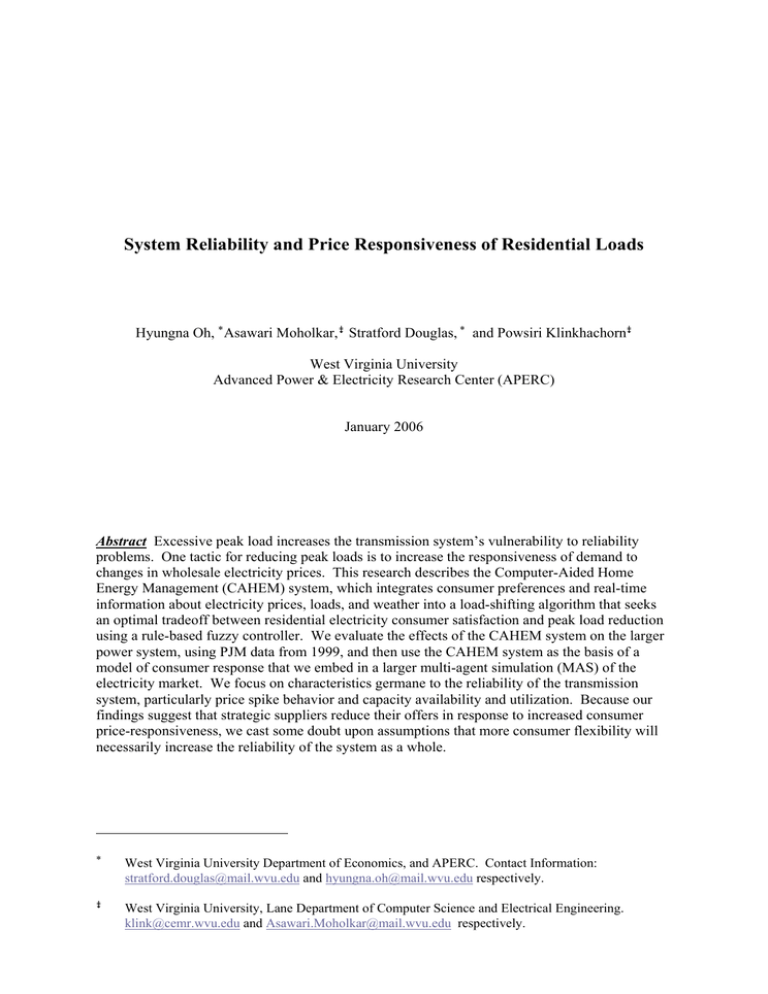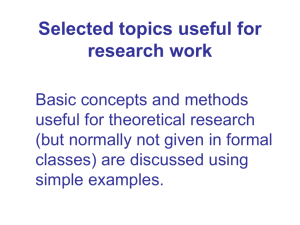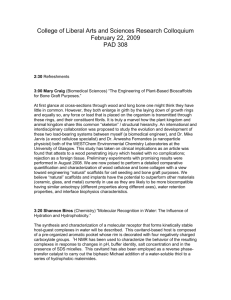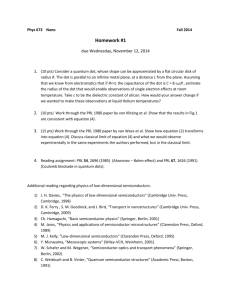System Reliability and Price Responsiveness of Residential Loads
advertisement

System Reliability and Price Responsiveness of Residential Loads Hyungna Oh, * Asawari Moholkar, Stratford Douglas, * and Powsiri Klinkhachorn West Virginia University Advanced Power & Electricity Research Center (APERC) January 2006 Abstract Excessive peak load increases the transmission system’s vulnerability to reliability problems. One tactic for reducing peak loads is to increase the responsiveness of demand to changes in wholesale electricity prices. This research describes the Computer-Aided Home Energy Management (CAHEM) system, which integrates consumer preferences and real-time information about electricity prices, loads, and weather into a load-shifting algorithm that seeks an optimal tradeoff between residential electricity consumer satisfaction and peak load reduction using a rule-based fuzzy controller. We evaluate the effects of the CAHEM system on the larger power system, using PJM data from 1999, and then use the CAHEM system as the basis of a model of consumer response that we embed in a larger multi-agent simulation (MAS) of the electricity market. We focus on characteristics germane to the reliability of the transmission system, particularly price spike behavior and capacity availability and utilization. Because our findings suggest that strategic suppliers reduce their offers in response to increased consumer price-responsiveness, we cast some doubt upon assumptions that more consumer flexibility will necessarily increase the reliability of the system as a whole. * West Virginia University Department of Economics, and APERC. Contact Information: stratford.douglas@mail.wvu.edu and hyungna.oh@mail.wvu.edu respectively. West Virginia University, Lane Department of Computer Science and Electrical Engineering. klink@cemr.wvu.edu and Asawari.Moholkar@mail.wvu.edu respectively. System Reliability and Price Responsiveness of Residential Loads Hyungna Oh, Asawari Moholkar, Stratford Douglas, and Powsiri Klinkhachorn I. INTRODUCTION Market failures in California and the recent blackout in the Northeast have raised doubts about market-based reforms in the electricity sector in the United States. Critics of market-based reforms have blamed them for increased prices and price volatility, market power problems, reduced reliability, and inefficient investment. Markets are more likely to have these problems when demand is price inelastic (Harvey and Hogan, 2000). Demand is highly inelastic in electricity markets, since most final consumers of electricity pay a flat regulated rate and hence do not even have the opportunity to respond to price changes. Defenders of market reforms therefore advocate increasing the exposure of consumers to changes in electricity prices in order to increase the price responsiveness of electricity demand. Our current research is intended to shed light upon how residential consumers may become more responsive to changes in electricity prices, and the effect of such increased consumer priceresponsiveness on the market as a whole. Accordingly, we describe a new system (ComputerAided Home Energy Management, or CAHEM) that uses fuzzy logic to facilitate residential consumer demand responsiveness to price, load, and weather. The system is designed to be inexpensive and simple to use, and to both shave and shift electricity usage away from peak periods without requiring significant consumer discomfort or effort. We evaluate the effects of the CAHEM system on system load using PJM data from 1999, and then use it to create a model of consumer response that we embed in a larger multi-agent simulation (MAS) of the electriicty market. Because our findings suggest that strategic suppliers reduce their offers in response to increased consumer price-responsiveness, we cast some doubt upon widespread assumptions that more consumer flexibility will necessarily increase the reliability of the system as a whole. There is little doubt that increasing the price responsiveness of electricity demand could allow this pivotal industry to deal with its market power problems and improve its efficiency. Price-responsiveness of load is generally considered to be a potent curb on generation market power. It could alter both the level and variability of prices, ameliorate price spikes, and redistribute rents among industry participants. How would this redistribution of risk and return affect reliability, and the political viability of dynamic pricing programs in the industry? This paper explores this question using multi-agent simulations, in the context of a technical improvement in the ability of residential customers to react to real-time price changes. Currently, engineers and economists in both academia and industry are pursuing a robust research and development effort aimed at increasing the price-responsiveness of electricity demand. Applied academicians are making advances in the theory of price-responsiveness in electricity markets (eg Joskow and Tirole 2004a, 2004b; Borenstein and Holland 2003, 2005), and in simulating its effects (e.g., Borenstein 2004; Holland and Mansur 2005; Mount and Oh, 2004). Real-world implementation of demand-responsiveness pilot programs began in the early 1980s, and is ongoing in California, Georgia, the Carolinas, New England, New York, Chicago, Wisconsin, and elsewhere. Summaries of the different types of price-responsive load programs may be found in Borenstein, Jaske and Rosenfeld (2002) (hereinafter “BJR”), GAO (2004), Lafferty, et al. (2001), and in many articles in the trade press. The most basic implementation is Time-of-Use (TOU) rates, which are flat, predetermined rates that vary either according to time of day, or seasonally, but do not respond to specific real-time events. Critical Peak Pricing (CPP) is generally considered to be more efficient than TOU, because it allows the utility to superimpose a predetermined much higher rate on a TOU structure at fairly short notice during critical shortages. BJR points out that interruptible load tariffs are roughly equivalent to CPP programs with very high critical peak rates. Real-Time Pricing (RTP) programs, which expose customers to all or most fluctuations in market rates, have been implemented primarily for large industrial customers. Holland and Mansur (2005) provide simulation results that suggest that monthly TOU rates can capture much of the benefits available from demand response without installing new meters, but others, such as BJR, share the consensus among experts that TOU is a poor approximation of RTP. RTP, while efficient, can be politically difficult to implement because it exposes consumers to price risk and has redistributive effects as well. One solution that has been tried in the industry is called a Demand Reduction Program, or DRP, in which the load-serving entity (LSE), offers a subsidy to customers who will reduce their usage during peak demand periods. The subsidy in effect increases the opportunity cost of peak-load consumption while transferring some rents to the consumer. Consumers are paid when they reduce their load relative to their customer-specific “baseline” level of usage. Criticism of these types of programs has been severe, and mostly centers on the fact that the baseline is difficult or impossible to determine satisfactorily in practice. Still, DRP is highly palatable to consumers, which makes it a possible path of least resistance toward greater demand responsiveness. DRP’s baseline problem may be obviated if the LSE pays instead for reductions that it directs from a central location, similarly to reliability-2- driven direct-demand control programs in New York state and Southern California and elsewhere, but along lines that are more tailored to the needs of the individual customer. It might charge a lower fixed rate to customers who agree to allow the LSE to install controls in their air conditioning, water heating, or other consumption devices so that the LSE or transmission system operator (ISO or ITC) can directly reduce consumption during peak demand periods. This alternative is attractive to the ISO because it provides specific controls that it can count on during system stress, rather than relying on voluntary consumer response to price changes, which are perhaps less reliable, and certainly less predictable. Current advances in metering and controls make it feasible to create a hybrid approach that allows the LSE and consumer each some measure of control over the system, using a sophisticated customer interface to design a system that responds predictably to system stresses and price spikes. The Computer Aided Home Energy Management System (CAHEM) illustrated in figure 1 uses such an interface, and is used as the basis for the simulations in this paper. Its design is further described in the appendix. This paper describes ongoing research into a hybrid program that provides incentives, along with hardware and software support, for a demand-response program tailored to residential customers. The larger goals of the research program are to design more palatable and successful price-sensitive demand response programs that provide strong incentives for implementation and penetration of price-responsive load (PRL) mechanisms. Through multi-agent simulations (MAS) we intend to test and demonstrate the relative effectiveness of the mechanisms we develop, in a realistic setting with heterogeneous agents and market power, and to test hypotheses about their effect on the power system as a whole. In section II of this paper we describe the Computer Aided Home Energy Management System (CAHEM) that we designed, and some simulations that assessed its ability to shift and shave peak load. In section III we briefly review the model of the supply side of the market, in which the generation agents operate. In Section IV we describe simulations that combine the models from Section II and III, placing price-responsive residential consumers on the demand side of a market with generators controlled by software agents on the supply side in various simulation scenarios. Section V describes the results of the simulations, and Section VI concludes. II. COMPUTER AIDED HOME ENERGY MANAGEMENT SYSTEM The Computer Aided Home Energy Management (CAHEM) system, described in Asawari (2005) enables the implementation of price-responsive load management for the residential sector. The prototype unit uses a personal computers already present in the house, but it can also -3- be implemented with a dedicated microcontroller system. Figure 1 represents a block diagram for peak load control with the CAHEM system. It consists of a computerized load control implemented with the help of X10 appliance controllers. The computerized control is composed of the following three units: 1. Load Models: Load models for the residential end-uses calculate hourly electricity consumption in a housing unit, which helps in designing optimal load shifting strategies. 2. User Interface: The user interface allows the user to set operational preferences for appliances, conveys the current level of appliance control to the customer, and controls the controller hardware. 3. Load Shifting Algorithm: This unit determines load shifting and appliance scheduling based on the price, load, and temperature data, along with customer preferences. It decides operational settings for residential appliances, e.g. thermostat setting of a central air conditioner. The controller hardware performs the actual control of the appliances. It consists of a programmable controller which interfaces to a personal computer and incorporates two-way transmission of powerline signals. A main controller sends control signals over existing electric wiring to the receiver modules dedicated to each appliance, which execute the commands. Residential End-Uses A typical urban house in the United States is equipped with a wide range of electricity enduse appliances. Major residential end-uses of electricity include air conditioning, water heater, lights, cooking appliances, refrigerator, dishwasher, washer, and dryer. Schweppe, Daryanian, and Tabors (1989) state that an end-use device ‘uses’ electricity to provide a ‘service’ to the consumer. In price responsive load control, the demand from the residential end-use devices can be altered by modifying the device’s usage, its service, or both. For some appliances the usage may be displaced relatively easily in time while the service may not (for example, air conditioning combined with thermal storage or inertia); for other appliances the service and usage may both be displaced (for example, clothes washing and drying). For others, such as lighting, service may be reduced in quality or amount, but neither service nor usage can be rescheduled without inconvenience to the consumer. Load Models Development of a fairly accurate representation of the residential hourly loads is one of the most critical steps in assessing the load management programs (Chan et al, 1981). The load models for each appliance under load management control helps to calculate the total hourly load for a house. Among all residential appliances, air conditioning contributes significantly to the residential load during the summer, thus offering a great potential for controlling total residential electricity demand (Pahwa and Brice, 1985). Because of the key importance of the air -4- conditioning load (about 40% of the energy used in a typical household), in this section we discuss the air conditioning load model in detail. The air conditioning load model is designed to calculate the hourly cooling load for given weather conditions and specified house structure. “Cooling Load” is the thermal energy that must be removed from the interior of a house in order to maintain the desired comfort conditions, normally specified by the interior dry-bulb temperature. The air conditioning load is controlled by a thermostat determining interior dry-bulb temperature. As inside dry-bulb temperature changes in effort to manage the cooling load, the load model must support hourly load calculations with a variable thermostat setting. Various methodologies for calculating residential air conditioner load based on statistical analysis of historic usage data can be found in the literature (e.g. Pahwa and Brice, 1985, Gellings and Taylor, 1981). However, these models can not be used in the analysis of the price responsive load control strategy because of lack of historic usage data reflecting the effect of a variable thermostat setting. Therefore, we used a physical model of an air conditioned house in this study, incorporating underlying physical principles, such as the thermodynamics of the house and the effect of both external and internal conditions on heat transfer across the house envelope. We made several simplifying assumptions, such as limiting the number of cooling zones within each house, assuming uniformity of building materials, and so on. We are left with a relatively simple yet reasonably accurate lumped parameter thermal network model of an air conditioned house, described in detail in Asawari (2005). The fundamental parameters in the model are cooling capacity of air conditioning equipment, thermostat setpoint, ambient weather conditions, and thermal properties of the house (Guttromson et al 2003). In order to facilitate the use of the residential air conditioner model at an aggregate level study, these parameters are set at different values in different houses, using random variables within expected rangesrange. For the air conditioning model, for example, we used a thermal comfort zone based on ASHRAE standards. Thermal comfort is subjective in nature, and it is dependent on a number of environmental factors, the two most important of which (temperature and humidity) are captured in the psychometric chart shown in Figure 2, and described in Fairey (1994). In our simulations, we set the thermal comfort zone at 68°F to 81°F, and set the CAHEM load controller in all houses to limit its operation to this comfort zone as much as possible. Asawari (2005) describes similar control models that are applied to water heater, washer/dryer, dishwasher, and lighting. -5- User Interface Software The graphical user interface for the CAHEM system is designed to enable the customer to enter choices for controller operation in terms that are easily understandable to the typical consumer. It also provides feedback to the consumer about appliance settings and the overall demand profile. It communicates with the bidirectional X10 controller that in turn configures and communicates with the appliance control modules, including the TempLinc™ module that controls the central air coditioner. The customer sets preferences as desired, choosing between comfort and peak-load reduction (economy). Maximizing comfort implies minimizing peak load reduction benefits, and vice versa. The customer may choose among (1) “Super-save,” (2) “Economy,” and (3) “Comfort” modes. Each mode sets the following parameters: 1. Price threshold: The load reduction mechanism activates when the price exceeds the price threshold. The higher the price threshold, the lower the incidence of load reduction operation. The setpoints for various modes are chosen in order to keep consistency with Oh (2003). 2. Temperature tolerance: The allowable variation in thermostat settings for the air conditioner. This setting is independent of the thermostat setting. 3. Minimum brightness of lights. 4. Minimum water heater performance: The fraction of water heater energy consumption, relative to desired settings. 5. Maximum delay for washer/dryer and dishwasher. The CAHEM user interface software is built on the MATLAB environment (Version 6.5 R13). It requires the Fuzzy Logic Toolbox installed with MATLAB. More detailed description of its operation, including screenshots of the interface, is available in Asawari (2005). Price Responsive Load Management Strategy The load management algorithm uses fuzzy logic to drive the CAHEM system. Fuzzy logic allows the control variables to be defined to have unclear boundaries. The controller can incorporate a simple rule-based inference system in which intuitively defined fuzzy rules govern the output of the controller, as described in Yen and Langari (1998). Fuzzy logic is used at two points in the system. First, the algorithm assesses the state of the power system based on price, load, and weather inputs from the LSE or utility. The price-load relationship is a very complex nonlinear process. As demand for electricity fluctuates during the day, the electricity price varies according to the shape of the supply curve. However, the supply curve itself varies on a daily or hourly basis, creating uncertainty and wide variation in the relationship between demand and price. If the condition of a power system is to be judged based -6- on price and load data, the decision boundary is not well-defined, and fuzzy logic is useful for charactrizing that boundary. Second, consumer preferences govern the limits of appliance control and define comfort criteria. The definition of comfort includes the thermal comfort of air, thermal comfort of hot water, and visual comfort as a result of illumination. An effective customer interface should not require the customer to describe comfort in precise quantitative terms, so fuzzy logic is useful for characterizing customer comfort. Classification of Hours Using price, load, and weather inputs, the controller divides daily hours into peak, off-peak, and pre-peak categories. Pre-peak hours are used for load-shifiting, with n-hour ahead notification. For example, with an air conditioner set to a lower temperature during pre-peak hours, the thermal inertia of a house will reduce the discomfort caused by higher temperature settings during peak hours. The classification of hours is carried out by a fuzzy inference system. A global template defining fuzzy sets is shown in Figure 3. The parameters of the membership function are tuned according to the customer selection. This fuzzy system determines the confidence associated with categorization of the hour. An hour is classified as a “peak” hour any time either load or price is “high.” If load is “not high” and price is “low,” then the hour is “not a peak hour.” Figure 4 shows the peak hour detection results for the 1999 PJM summer data with the fuzzy membership functions shown in Figure 3. The extent of advanced price notification plays a very important role in the development of the load control algorithm. Load shifting to non-peak hours is possible if the load controller receives sufficient advance notification. We looked at different scenarios for the number of hours ahead notification is provided of a coming peak load. In the simplest case, with one-hour ahead notification of a coming peak, the controller reduces demand during the peak; with n-hour ahead notification the controller is able to shift some demand from peak to off-peak hours. Load control during the peak hours During peak hours, the CAHEM tries to minimize electricity usage for residential appliances while maintaining the customer’s comfort within acceptable margins. The controller reschedules the reschedulable services to an off-peak hour if it is within the maximum delay set by customer. In the absence of the off-peak hour in the delay span for operating reschedulable services, the services are rescheduled to the peak hour with the lowest price. If the reschedulable services for enough households are rescheduled at the lowest price hour, it may create a new peak load hour. Therefore, the rescheduling is done randomly within the acceptable hours. The fuzzy controller also takes into account if non-reschedulable loads are operated during the peak hour under consideration. -7- The thermostat setting is determined based upon price and load data, which are each classified into fuzzy sets of low, medium, and high. The temperature setting is also classified into three fuzzy sets: Desired, Warm, and Warmer. The spread of the membership function will change according to customer preferences. Similar, separate, classifications apply to the water heater and lighting settings. Fuzzy Rules for Appliance Controls: 1. If the load is not high and the price is low, all appliances are set at the desired settings. 2. If the load is high and the price is low, then the thermostat setting is warm, water heater is warm, and lights are dim. 3. If the load is high and the price is medium, then the thermostat setting is warm, water heater is cool, and lights are dimmer. 4. If the load is not high and the price is medium, then the thermostat setting is warm, water heater is warm, and lights are dim. 5. If the load is high and the price is high, then the thermostat setting is warmer, water heater is cool, and lights are dimmer. 6. If the load is medium and the price is high, then the thermostat setting is warmer, water heater is warm, and lights are dim. 7. If the load is low and the price is high, then the thermostat setting is warm, water heater is warm, and lights are dim. When n-hour ahead notification is available, pre-peak settings are controlled using a similar fuzzy algorithm designed to make use of the thermal inertia of the house to set the thermostat to a lower temperature in advance of the peak. The originally scheduled or newly scheduled reschedulable loads are operated as per the customer's preferences. Simulations to Evaluate CAHEM Performance The evaluation of the CAHEM load management system was conducted using the hourly data from the Pennsylvania- New Jersey- Maryland (PJM) market from June 1, 1999 to August 31, 1999. Summer peak during this period was 51.7 GW, and price was limited to $999/MWh. We used data on hourly temperatures in Allentown, Philadelphia, Pittsburgh, Albany, New York City, Buffalo, Boston, and Washington DC to provide input into the controller for the simulation. Simulated controller action for a typical house is summarized in Figure 5, for both the one-hour and 12-hour advance notification. Note the effectiveness of the load-shifting algorithm for the 12-hour case. We then simulated the impact of various levels of penetration of the CAHEM system on the entire PJM market. The PJM market served approximately 33 million household in 1999. It is computationally impossible to individually model each house with different construction properties and customer preferences. Therefore, 100 different of classes of houses representing the complete residential sector were considered. The housing units in the given territory are -8- equally distributed into 100 different classes. The variety of house construction properties and appliance is incorporated by using random number generators using uniform or Gaussian distributions as appropriate, restricted within the expected range, and allowing high correlation between with floor area and energy consumption highly correlated. The following four scenarios for the distribution of customer preferences are considered: 1. ‘Super-Save’: All households operating in ‘Super-Save’ mode. 2. ‘Economy’: All households operating in ‘Economy’ mode. 3. ‘Comfort’: All households operating in ‘Comfort’ mode. 4. ‘Random’: Operating mode for each household is randomly chosen from the above three modes, assuming operating modes have uniform distribution. The table below summarizes peak load reduction with the various operating modes and 50% market penetration. With a one-hour prior notification, 1 to 3 % peak load reduction (500 to 1500 MW) is achievable. With a 12-hour-ahead notification, there is more peak load reduction but also load shifting to hours with relatively low loads. Trading off reduction of the anticipated peak against creation of a new peak through load-shifting, the optimal CAHEM participation level for all modes seems to be between 20 to 60%. Advance notification results in about 2.5% -4.25% peak load reduction, assuming 50% CAHEM participation. Future work will address the problem of smoothing this secondary peak and improving the macro-performance of the algorithm. Table 1: CAHEM Performance III. IMPACTS OF PRL ON GENERATION SUPPLIERS In an imperfectly competitive market, a supplier of generation will change its offer strategy when the demand curve becomes more elastic. Few serious analysts of electricity markets are willing to assume that real-world electricity markets are perfectly competitive; therefore a complete analysis of the impact of PRL must take account of reactions of suppliers to the PRL-9- induced increase in demand elasticity. To deal with the complexity of imperfectly competitive markets, following Oh and Mount (2004) and Mount and Oh (2004) we will employ the supply function equilibrium (SFE) framework developed by Klemperer and Meyer (1989), and apply it to a multi-agent-based simulation. In the SFE analysis, each supplier faces a residual demand curve comprising the portion of the industry demand curve that is unserved by other suppliers. The industry demand curve is Q = D (P ) . To simplify matters, assume two symmetrical generation suppliers (gencos), i and j, who choose their supply functions (offer curves) simultaneously. Assume that there is a unique market-clearing priceP* such that D ( P * ) = S i ( P * ) + S j ( P * ) . At P*, supplier i with cost function C (Qi) earns profit P* S i − C (Si(P*)). Klemperer and Meyer (1989) add a stochastic term e to account for uncertainty as to the location of the demand curve. Supplier i’s profit maximizing price along its residual demand curve may be obtained by solving equation (1), (1) Max P ⋅ [ D ( P, e) − ⋅S j ( P )] − C ( D ( P, e) − S j ( P )) , Pr which yields the first-order condition (2) D( P, e) − S j ( P) + P ⋅ [ D′( P, e) − S ′ j ( P)] − [C ′( D( P, e) − S j ( P))] ⋅ [ D′( P, e) − S ′ j ( P)] = 0 . In a symmetric equilibrium, the profit maximizing offer price for generator i is therefore (3) P = C ′(⋅) + D ( P, e ) − S j ( P ) . S ′ j ( P ) − D ′( P, e) Because the numerator of the second term on the right-hand of (3) is supplier i's residual demand curve Qi, the symmetric equilibrium supply function for generator i is (4) P = C ′(⋅) + Qi . S ′ ( P ) − D ′( P, e) j Note that the derivative of the demand function with respect to price is non-positive: D'(P) ≤ 0. The derivative D'(P) is zero if the demand curve is perfectly inelastic, and becomes more negative (more elastic) as PRL comes to control an increasing share of the load. As price elasticity of demand increases, D'(P) becomes more negative and S' j(P) − D'(P) increases, which decreases the second term on the right-hand side of (4), which makes the optimal offer price for Qi fall. Thus, PRL mitigates generator market power by increasing the elasticity of demand. Although PRL mitigates strategic capacity witholding by reducing generators’ ability to manipulate prices, its overall effect on capacity availability is unclear. PRL-induced voluntary “load shedding” may still induce capacity withholding by changing the density function of the load. That is, an effective PRL program will decrease the probability that the load will be high at - 10 - any given time. When the probability of high loads falls, the probability of high prices also falls, gencos will be less likely to profit by making generating units with high marginal costs available, and therefore fewer units will be available for dispatch at any given time. This issue is important since reduced capacity availability reduces the reserve margin, which may reduce reliability. Algebraic analysis alone provides little indication as to the net effect of PRL on capacity availability, so we turn to simulation tools to investigate the net effect of PRL on capacity withholding. IV. SIMULATIONS We test the impact of PRL using a multi-agent system (MAS) framework. MAS uses a structured form of Adaptive Autonomous Agent to represent suppliers participating in a uniform price auction run by an ISO. Suppliers use observed market outcomes to estimate the residual demand curve for their generating capacity. These estimates are updated using a Kalman filter, and as a result, the behavior of the suppliers can change during a simulation. The objective of each supplier is to maximize expected profits. The analysis focuses on investigating changes in price, demand and offer strategy of suppliers affected by the implementation of the PRL program. All scenarios employ twelve generation suppliers, comprising four large suppliers and eight small suppliers. A large supplier controls 10 GW of generating capacity, split into six blocks (4.5, 1.5, 1, 1, 1, 1), while a small size supplier controls 2.5GW. All suppliers have similar cost structures, ranging from base load to peaking capacity. The share of total capacity controlled by a large supplier (17%) corresponds roughly to the largest suppliers in a market such as the Pensylvania - New Jersey - Maryland (PJM) market. The suppliers differ as to: 1) generation capacity (large vs small); 2) vertical integration status (two large firms are vertically integrated, while the other ten suppliers are all gencos); and 3) perception of the market (each supplier has a different residual demand curve). A. Simulation Scenarios We investigate behavior of the generation supplier agents under four different market environments, designated E0 – E3. These environments differ as to the presence or absence of PRL programs, and as to the ability of suppliers to bid strategically. There is no PRL program in E0 or E1. E0 is a perfectly competitive market in which generators bid marginal costs, while E1 – E3 allow strategic bidding by generators seeking to exercise market power in a SFE framework. PRL programs are present in E2 and E3, but generators’ bidding behavior is more restricted in E2. There is PRL with strategic bidding in E2, but generators must bid the same offer curves as in E1. This restriction is relaxed in E3. - 11 - Simulation results from E0 and E1 provide base cases to evaluate the effect of PRL programs tested in E2 and E3. A comparison of E0 with other scenarios allows us to access the magnitude of market inefficiency in each scenario. E1, in contrast, provides a supplier-friendly scenario in which price manipulation does not affect sales. E2 provides a “naïve” policy outcome that would obtain if suppliers ignored the effects of PRL on their sales, and therefore their profits. Environment E3 is more realistic, as it allows suppliers to maximize their expected profits under PRL, and it therefore illustrates the dynamic overall impacts of PRL on market outcomes. In order to assess the sensitivity of outcomes to PRL design, the aggressiveness of PRL programs in E2 and E3 is allowed to vary along two dimensions: customer participation (20% vs 40%) and threshold price for customer response ($300 vs $500 per MWh). These 2-by-2 combinations make four different sets of PRL scenarios in each of E2 and E3, or eight in all. With the base case (E1) and the perfectly competitive case (E0), there are a total of ten simulation scenarios. The ten simulation scenarios are summarized in table 2. Table 2 : Simulation Scenarios The supplier’s behavior is Suppliers adjust offer behavior unaffected by the PRL program responding to the PRL program Threshold Participation price $500/MWh $300/MWH $500/MWh $300/MWh percentage 0% (No PRL) Perfectly Competitive Market (E0) 0% (No PRL) Base Scenario (E1) 20% E2-S21 E2-S22 E3-S31 E3-S32 40% E2-S23 E2-S24 E3-S33 E3-S34 Each simulation scenario involves a series of 92 auction days (i.e. 2208 hours) which correspond roughly to the daily auctions from June 1, 1999 to August 31, 1999 in PJM. The aggregate impact of load management with our PRL is tested using temperature, load and price data in PJM consisting of about 17 million households. 1 The thermostat setting may be varied across simulations, but we choose to set the comfort level at 78ºF, with the consumers allowed to increase the thermostat setting to 83ºF in response to high electricity prices. A price cap of $1,000/MWh is imposed on the market. 1 Temperature data is the average of temperatures from Allentown, Albany, Boston, Buffalo, Washington, New York and Philadelphia. - 12 - We evaluate simulation outcomes using a variety of metrics. Average price is an indicator both of efficiency (when compared to the E0 price of $26.6/MWh), and likely customer satisfaction with the market. Procurement cost provides a measure of transfers from LSEs to generators. Reserve margin and price spike measures are used to indicate risk. The percentage of time with price spikes above $300 is one measure of price risk faced by the LSE. Also, price spikes affect incentives to build new plants, especially peakers. The percentage of time with reserve margins below 10% is a measure of system reliability. Because reserve margin represents extra supply capacity available to respond to unexpected events, the power system becomes less reliable when the reserve margin decreases. B. Simulation Results Simulation results are summarized in table 3 and figure 7. Results in general are in line with expectations, with E0 outperforming both actual PJM outcomes and the other simulations. The average price in the competitive, no-PRL market (E0) is $26.6/MWh. We observe neither price spikes above $300/MWh nor hours with a reserve margin below 10% of the hourly load. Average procurement cost is $2 billion per summer peak hour. In environment E1, with strategic offers and perfectly inelastic demand, the average price is $94.7/MWh, which is an increase of 260% relative to E0. Because demand is perfectly inelastic, the average hourly procurement cost increases in E1 at the same rate. Price spikes above $300/MWh occur for 5.9% of the total summer hours. The reserve margin dips below 10% of hourly load for 13% of the total summer hours, due to suppliers’ strategic withholding of capacity to manipulate price. The E1 simulations replicate with some accuracy the actual market performance during this period in PJM, including extremely high offers and significant capacity withholding. Compared to the actual PJM outcomes, the multi-agent system in E1 generated somewhat higher average prices and more hours of low reserve margin. These deviations are to be expected, as the simulated market does not include some relevant aspects of the real market, such as forward contracts, suppliers’ fear of regulatory intervention, and pro-competitive ISO activity. However, our MAS appears to be reasonably successful in replicating a market in which suppliers exercise market power that may be addressed by PRL programs. First PRL Case (E2): PRL with Naïve Suppliers In environment E2, in which consumers respond to high prices, but suppliers’ behavior is naïvely unaffected by PRL, most outcomes are improved relative to E1. Given E2’s naïve suppliers, PRL is able to reduce hourly load fluctuation within a typical day by increasing the minimum load and decreasing the maximum load. It reduces average price by 11.5%, and - 13 - independent load serving entities’ power purchase costs fall by more than 40% relative to E1. The E2 simulations also suggest that PRL can reduce risk , both by increasing the reserve margin and eliminating most price spikes. Figure 8 illustrates how the PRL program produces these changes. As shown in figure 8, the market supply curve that applies in both E1 and E2 has the characteristic “hockey stick” shape: it is flat at low levels of output and sharply at high levels when the peaking units come on line. Without PRL in E1, much more of the hourly load is on the upward sloping part of the market supply curve and, consequently, price spikes persist. With PRL, some of the peak load is shifted from peak-hours to pre-peak hours by pre-cooling, and some is shed by adjusting the air conditioner thermostat to the maximum comfortable level during periods of high prices. As a result, daily load fluctuation decreases as the minimum load rises and the maximum load falls. Figure 9 illustrates this reduction in load fluctuation, comparing three load duration curves obtained in E1, E2-S21 and E2-S24. The duration of extremely high loads decreases with PRL, but moderate “shoulder” load durations increase due to load shifting. Table 3: Simulation Results (Percentage figures in parentheses are differences relative to Base Case, E1) Actual PJM Outcome E0 (Competitive, No PRL) E1 (Base case, No PRL) S21 (0.2, $500) E2 (PRL1) S22 (0.2, $300) S23 (0.4, $500) S24 (0.4, $300) S31 (0.2, $500) E3 (PRL2) S32 (0.2, $300) S33 (0.4, $500) S34 (0.4, $300) Average Load (GWh) 34.0 34.0 34.0 33.5 (-1.5%) 33.5 (-1.5%) 33.4 (-1.8%) 33.4 (-1.8%) 33.9 (-0.3%) 34.0 (0%) 33.9 (-0.3%) 33.9 (-0.3%) Average Price ($/MWh) 53.7 26.6 94.7 57.0 (-39.8%) 54.5 (-39.8%) 57.0 (-42.5%) 54.3 (-42.7%) 88.4 (-6.7%) 77.0 (-18.7%) 76.8 (-19%) 69.2 (-27%) n * Reserve margin (R.M.) = ( q / D ) − 1 ∑ i,t t i =1 - 14 - Percent of Time Price Above $300/MWh 3.5 0.0 5.9 0.5 (-90.8%) 0.0 (-100%) 0.5 (-90.8%) 0.0 (-100%) 5.6 (-6.1%) 4.4 (-25.2%) 4.3 (-26.7%) 3.8 (-36.6%) % of Time Reserve Margin below 10%* N.A. 0.0 13.1 11.5 (-12.8%) 11.5 (-12.4%) 11.5 (-12.8%) 11.5 (-12.4%) 9.4 (-28.6) 11.5 (-12.8%) 10.9 (-17.2%) 13.0 (-1.4%) Average Cost ($million) 4,031 1,997 7,109 4,216 (-40.7) 4,031 (-43.3%) 4,204 (-40.9%) 4,004 (-43.7%) 6,617 (-6.9%) 5,781 (-18.7%) 5,749 (-19.1%) 5,180 (-27.1%) A similar pattern is observed in the price duration curves in figure 10. Both the level and the duration of peak prices significantly decreases in E2 compared to E1. Table 3 shows a 90.8% to 100% decrease in the proportion of price spike hours, depending on whether the threshold price is set high or low. Lower threshold prices are more effective in mitigating high prices than high threshold prices. This price reduction effect of PRL is directly reflected in the costs of purchasing power from the spot market, which decreases by more than 40% in E2 relative to E1. 2 PRL appears to improve system reliability as well, as indicated by the 12.4% to 12.8% reduction in the proportion of time that the reserve margin falls below 10%. Second PRL Case (E3): Suppliers React Strategically to PRL The significant benefits of PRL indicated in the scenario E2 simulatios may be at least partially illusory, however, as indicated by the results of scenario E3. The E3 simulations relax the assumption of passive suppliers (gencos), and allow them to change their strategic behavior in response to the implementation of PRL. Figure 11 shows how suppliers adjust the market supply curve when PRL exists in the market. Compared to E1 (upper panel), the market supply curve becomes relatively flat in the aggressive PRL case (E3-S34, middle panel of figure 11). As predicted by SFE theory, the supply curve does not include high price offers. However, the total quantity of generation submitted into the market is less in this case than in E1, possibly reducing reliability and leaving the market more open to disruption. When PRL is relatively modest (E3S31, bottom panel of Figure 11), suppliers do not withhold capacity, but instead speculate with more of their capacity by offering it at a higher price. This implies that suppliers do not give up hope of exercising market power and generating price spikes if PRL is modest. Figure 12 provides more information about the observed patterns of offer prices and quantities. Compared to the competitive case, suppliers withhold most of their capacity in all scenarios, but withhold the most in response to the most aggressive PRL (S34). As evidenced by the relatively low offer prices, however, this withholding in the face of aggressive PRL occurs because suppliers expect prices to be too low to cover their costs, not because they are hoping to manipulate prices by withholding. Because the responsive suppliers of E3 offer less capacity than the naïve suppliers of E2, PRL is less effective at mitigating high prices in E3 than in E2. As shown in table 3, prices in E3 are still 7% to 27% lower than in the base case (E1), but they are significantly higher than they would be if suppliers were naïve (E2). The same pattern holds for procurement cost savings and price spike mitigation. 2 We assume that load serving entities purchase electricity only from the spot market. - 15 - The biggest difference between the naïve (E2) and responsive (E3) suppliers, however, is in the reduced ability of PRL to mitigate price spikes. Table 3 shows a near-total reduction of price spikes if suppliers are naïve (E2), but much less of a reduction in the duration of high price periods if suppliers respond to PRL (E3). This point is made even more dramatically in figure 13, in which the E3 price spikes (solid line, left panel), though less numerous than the E1 price spikes (dottled line), are just as high. These results imply that PRL may not be the panacea for LSE price risk that many hope for. In addition, figure 15 shows few changes in the load duration curve due to PRL in E3 relative to the base case (E1). This may occur because of a reduction in load-shifting, as it may cause price spikes to occur in shoulder periods when there is less capacity available. The simulation results from E3-S32 and E3-S33 summarized in table 3 and figure 7 indicate that a PRL program that covers relatively few households (20%), but that responds at relatively low prices ($300/MWh) is as effective in curbing market power as a program that covers more households (40%), but begins at higher prices ($500/MWh). Two important reasons often given for implementing PRL are to mitigate high prices and to improve reliability. These simulations suggest that these two motives may conflict, however, when suppliers adjust their offer strategy in reaction to PRL. As PRL becomes aggressive (i.e, as the scenario moves from S31to S34), high prices are mitigated but the reserve margin decreases (see table 3 and figure 7). VI. SUMMARY AND CONCLUSIONS A self-regulating market should discipline suppliers that submit high price offers by reducing the amount of capacity dispatched. Increasing the price responsiveness of electricity consumers is widely viewed among researchers as a highly effective way to achieve this. Previous research in this area has generally focused on the industrial consumer PRL, residential appliance development, or the market power effects of PRL. The first part of this paper describes a new system (CAHEM) designed to increase the ability of residential consumers to participate in the electricity market. The CAHEM system allows residential customers to express their preferences, anticipate price and temperature fluctuations, and react to price changes with minimal effort, expense, or discomfort. The controller system uses an innovative fuzzy logic algorirthm to achieve peak load reductions of around 3% with little effect on consumer comfort. The simulations in the second part of the paper assess the effectiveness of a PRL program in the face of realistic supplier response. We place our CAHEM residential consumers intoa multi- 16 - agent system environment in which software agents represent generation companies. The analysis focuses on investigating changes in price, load, procurement cost of LSEs, and offer strategy of suppliers affected by the implementation of PRL using a residual demand function framework in Section 3 and a MAS simulation in Section 5. The overall conclusions from the results are that PRL can indeed mitigate high prices, improve system reliability, and reduce price volatility faced by load serving entities, but that its benefits may be reduced if sellers are able to respond strategically. The simulation results suggest that the structure of the load response program matters. A modest PRL program with a high threshold price and a small customer participation base may be relatively ineffective in mitigating high prices, but it may increase reliability because suppliers will offer sufficient capacity to maintain a relatively high reserve margin. On the other hand, an aggressive PRL program with a low threshold price and a large customer base may be more effective in mitigating mark-up pricing, but the lower prices may discourage generators from offering high-cost capacity and hence reduce the reserve ratio. This reduction of the reserve ration is a danger signal, warning that the lower prices caused by consumer responsiveness have some potential for actually reducing system reliability. Actual PRL programs implemented in the New York ISO and New England ISO markets comprise a much smaller proportion of households than any of our PRL combinations, and they begin response at a high threshold price ($500/MWh). Therefore, it is not realistic to expect these PRL programs to produce great benefits in terms of increasing reliability and reducing the risk exposure of load serving entities. This study suggests that the most fruitful way of improving these PRL programs should be to lower the price threshold at which demand response begins, since load responses with few participants at relatively low prices are as effective as load responses with many participants at high prices. More research is needed to extend the results and methods to small commercial customers, and to assess the overall effects of consumer demand-responsiveness on system reliability. REFERENCES Andrews, J.W., M. Piraino, and J. Strasser (1993). “Laboratory Testing of Control Strategies To Reduce Peak Air-Conditioning Loads,” ASHRAE Transactions 99(1): 518-528. Borenstein, Severin (2004) “The Long-Run Effects of Real –Time Electricity Pricing.” University of California Energy Institute CSEM Working Paper 133. Borenstein, Severin, James Bushnell, and Frank A. Wolak (2002). “Measuring Market Inefficiencies in California’s Restructured Wholesale Electricity Market,” American Economic Review 92(5): 1376-1405. - 17 - Borenstein, Sevein, and Stephen P. Holland (2005). “On the Efficiency of Competitive Electricity Markets with Time-Invariant Retail Prices.” RAND Journal of Economics Forthcoming. (Earlier edition, University of California Energy Institute CSEM Working Paper 116, 2003). Borenstein, Severin, Michael Jaske, and Arthur Rosenfeld (2002). “Dynamic Pricing, Advanced Metering and Demand Response in Electricity Markets,” University of California Energy Institute CSEM Working Paper 105 (October). Chan, Man-Loong, G. B. Ackerman, E.N. Marsh, J.Y. Yoon, and N. Stoughton (1981). “Simulation-Based Load Synthesis Methodology for Evaluating Load-Management Programs,” IEEE Transaction on Power Apparatus and Systems, Vol. PAS100(4), April, 1771-1778. Chen, Allan (2004). “Study Examines Performance of Utility Real Time Pricing Programs”, The Consortium for Electric Reliability Technology Solutions. Energy Cooperative, “Energy-Smart Pricing Plan- Reference Guide” [Online] Available at: http://www.energycooperative.org/pdf/ReferenceGuide_English.pdf P.W. Fairey (1994). “Passive Cooling and Human Comfort,” Florida Solar Energy Center Publication DN-5, January. Available at: http://edis.ifas.ufl.edu/pdffiles/EH/EH22100.pdf Gellings, C.W., and R.W. Taylor (1981). “Electric Load Curve Synthesis- A Computer Simulation of an Electric Utility Load Shape,” IEEE Transaction on Power Apparatus and Systems, PAS-100(1), January, 60-65. Goldman, Charles A., Michael Kintner-Meyer, and Grayson Heffner (2002). “Do Enabling Technologies Affect Customer Performance in Price-Responsive Load Programs?” May. Lawrence Berkeley National Laboratory, LBNL-50328. Available at: http://repositories.cdlib.org/lbnl/LBNL-50328 Guttromson, R.T., D. P. Chassin and S. E. Widergren (2003). “Residential Energy Resource Models for Distribution Feeder Simulation,” Proc. IEEE PES General Meeting, Toronto. Harvey, Scott M. and William W. Hogan, 2000, “California Electricity Prices and Forward Market Hedging”, mimeo, Harvard University. Holland, Stephen P. and Erin Mansur (2005) “The Distributional and Environmental Effects of Time-Varying Prices in Competitive Electricity Markets.” University of California Energy Institute CSEM Working Paper 143 (May). Joskow, Paul, and Jean Tirole (2004a) “Reliability and Competitive Electricity Markets.” University of California Energy Institute CSEM Working Paper 129 (April). Joskow, Paul, and Jean Tirole (2004b) “Retail Electricity Competition.” NBER Working Paper 10473 (May). Klemperer, Paul D., and Margaret A. Meyer (1989). “Supply Function Equilibria in Oligopoly under Uncertainty.” Econometrica 57(6): 1243-1277. Kreder, J.E., and Ari Rabl, Heating and Cooling Buildings: Design for Efficiency, McGraw-Hill, Inc., ISBN_ 0-07-834776-9. Lafferty, Ronald, David Hunger, James Ballard, Gary Mahrenholz, David Mead, and Derek Bandera (2001). “Demand Responsiveness in Electricity Markets.” Office of Markets, Tariffs, and Rates, Federal Energy Regulatory Commission, January. Lu, Ning, and David Chassin (2004a). “A state-queuing model of thermostatically controlled appliances,” IEEE Transaction on Power Systems 19(3). - 18 - Lu, Ning, David Chassin and Steve Widergren (2004b). “Simulating Price Responsive Distributive Resources,” IEEE Power Systems Conference and Exposition, October. Matsukawa, Isamu (2004). “The effects of information on residential demand for electricity”, The Energy Journal 25(1) 1-18. Mount, Timothy, and Hyungna Oh (2004). “Evaluating Alternative Ways of Mitigating High Prices in Electricity Markets Using Multi-Agent Simulations.” Mimeo, Department of Applied Economics and Management, Cornell University. Oh, Hyungna (2003). “Simulation Methods for Modeling Offer Behavior and Spot Prices in Restructured Markets for Electricity,” Ph.D. Dissertation, Cornell University. Oh, Hyungna, and Timothy Mount (2004). “Modeling Strategic Offer Behavior in Restructure Markets for Electricity.” Mimeo, Department of Applied Economics and Management, Cornell University. Pahwa, A. and C.W. Brice (1985). “Modeling and System Identification of Residential Air Conditioning Load,” IEEE Transaction on Power Apparatus and Systems, Vol. PAS- 104(6), June, 1418-1425. Schweppe, F.C., B. Daryanian, and R.D. Tabors (1989). “Algorithms for a spot price responding residential load controller.” IEEE Transaction on Power Systems 4(2) Siddiqui, Afzal S. "Price-elastic demand in deregulated electricity markets" (2003). Lawrence Berkeley National Laboratory. LBNL-51533. May. http://repositories.cdlib.org/lbnl/LBNL-51533 U.S. Government Accounting Office (US GAO) (2004). Electricity Markets: Consumers Could Benefit from Demand Programs, but Challenges Remain. Report to the Chairman, Committee on Governmental Affaris, U.S. Senate. GAO-04-844. Available at http://www.gao.gov/cgi-bin/getrpt?GAO-04-844. August, 2004. Yen, J., and R. Langari (1998). Fuzzy Logic: Intelligence, control, and information, Upper Saddle River, NJ: Prentice-Hall. - 19 - Figure 1: Block Diagram of Computer-Aided Home Energy Management (CAHEM) System Figure 2: Thermal Comfort Zone (Source: www.linric.com) - 21 - FIGURE 3: MEMBERSHIP FUNCTIONS FOR THE HOUR CLASSIFICATION FUZZY UNIT - 22 - FIGURE 4: FUZZY CLASSIFICATION OF PEAK HOURS IN PJM, 1999 - 23 - FIGURE 5: HOUSE-LEVEL RESULTS ONE-HOUR AHEAD (NO LOAD SHIFTING) - 24 - N=12-HOUR AHEAD (WITH LOAD-SHIFTING) FIGURE 7: MARKET SIMULATION RESULTS Ave_load (GW/h) Ave_price($/MWh) % of hours with price spike >$300 (%) % of hours with reserve margin <0.1 (%) GW/h, $/MWh 100 % 20 80 16 60 12 40 8 20 4 0 0 E0 E1 S21 S22 S23 E2 - 25 - S24 S31 S32 S33 E3 S34 FIGURE 8: THE IMPACT OF PRL ON LOAD AND PRICE WHEN SUPPLIERS ARE UNAFFECTED BY PRL (E2) Range of the Load - 26 - FIGURE 9: CHANGES IN THE LOAD DURATION CURVE IN WHEN SUPPLIERS ARE UNAFFECTED BY PRL (E2) On-Peak Load Decreases Pre-Peak Load Increases GW/h % of hours - 27 - FIGURE 10: CHANGES IN THE PRICE DURATION CURVE WHEN SUPPLIERS ARE UNAFFECTED BY PRL (E2) $/MWh $/MWh % of hours - 28 - % of hours FIGURE 11: CHANGES IN THE MARKET SUPPLY CURVE IN RESPONSE TO PRL (E3) < E1> NO PRL Range of the Load < E3-S34> AGGRESSIVE PRL: Threshold price=$300 % of Participation =40% Range of the Load <E3-S31> MODEST PRL Threshold price=$500 % of Participation =20% - 29 - FIGURE 12: CHANGES IN OFFER BEHAVIOR Ave(total quantity offered) 62 500 450 400 350 Ave(maximum price offered) 58 300 250 200 150 100 54 50 46 E0 E1 - 30 - S21 S22 S23 S24 S31 S32 S33 S34 FIGURE 13: IMPACTS OF THE PRL ON SPOT PRICES E1 E3-S31 E1 E3-S32 E1 E3-S33 E1 E3-S34 < E2: Naive Suppliers < E3: Suppliers Reduce Capacity Offers Due to PRL - 31 - FIGURE 14: CHANGES IN THE PRICE DURATION CURVE IN E3 - 32 - FIGURE 15: CHANGES IN THE LOAD DURATION CURVE IN E3 On-Peak Load Reduction GW/h Pre-Peak Load Increase % of hours - 33 -







